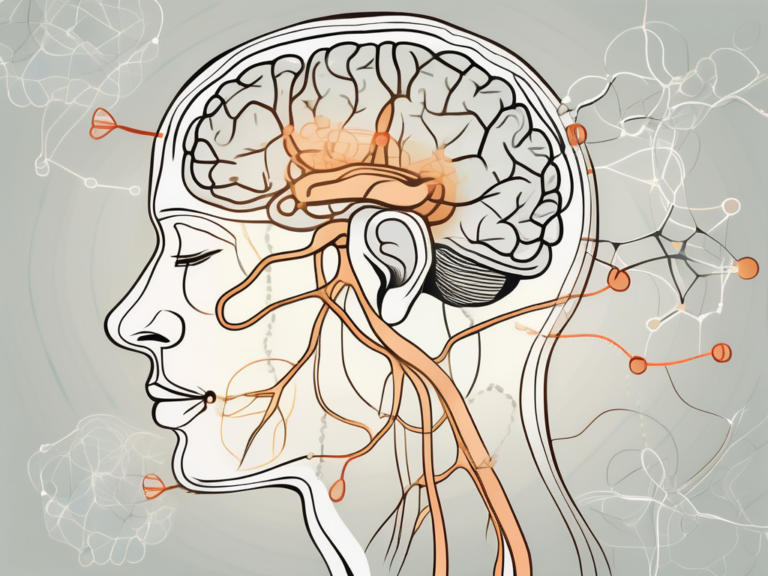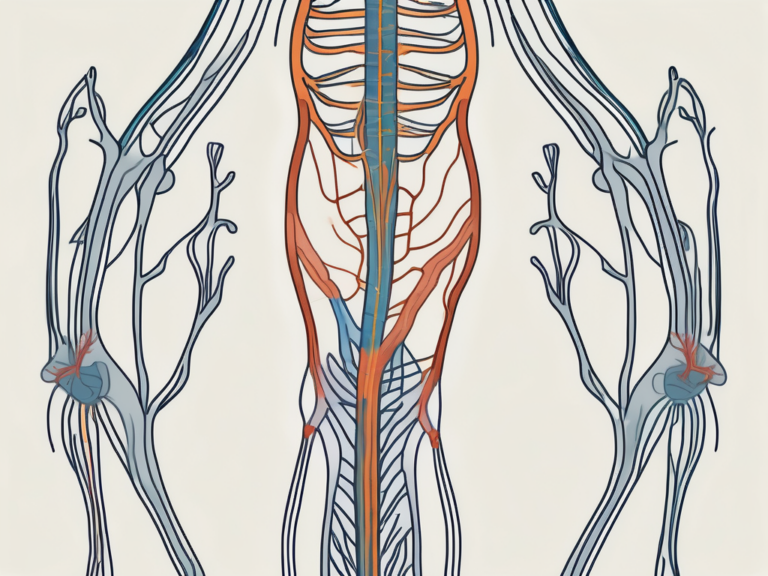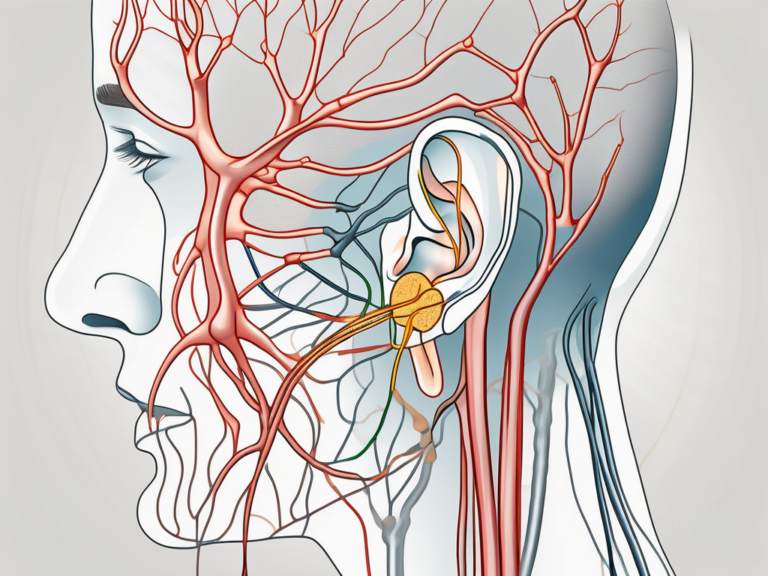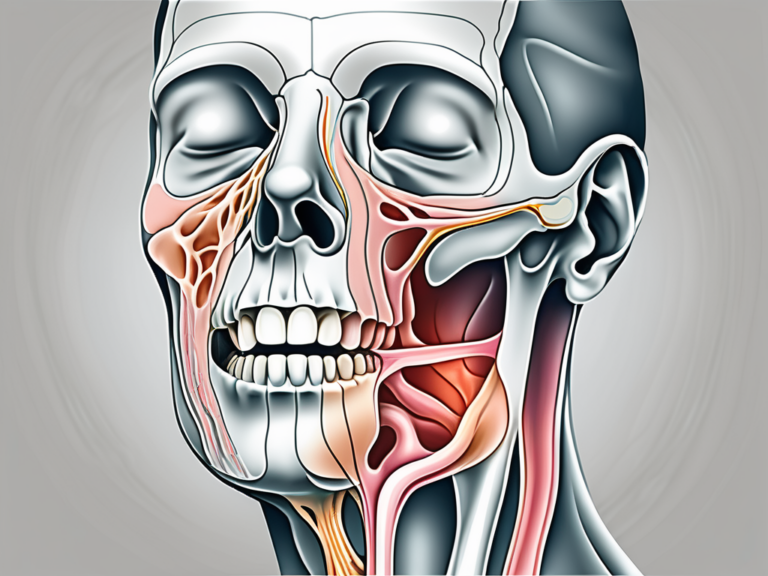Understanding the Role of Sympathetic Nerves in the Body
The human body is an intricate network of systems working together to maintain balance and ensure proper functioning. One of the key players in this orchestra is the sympathetic nervous system. The sympathetic nerves are part of the autonomic nervous system, which is responsible for regulating essential bodily functions. Understanding the role of sympathetic nerves in the body is vital in comprehending the intricate mechanisms that keep us functioning optimally.
An Overview of the Nervous System
Before delving into the details of the sympathetic nervous system, it is important to have a basic understanding of the nervous system as a whole. The nervous system is a fascinating and intricate network of cells, tissues, and organs that allows us to perceive and interact with the world around us. It is divided into two main parts: the central nervous system (CNS) and the peripheral nervous system (PNS).
The CNS, consisting of the brain and spinal cord, serves as the command center for all bodily functions. It is like the conductor of an orchestra, orchestrating the symphony of signals that flow through our bodies. The brain, with its billions of neurons, is responsible for receiving and interpreting sensory information, analyzing it, and generating appropriate responses to maintain homeostasis. Meanwhile, the spinal cord acts as a superhighway, relaying messages between the brain and the rest of the body.
On the other hand, the PNS comprises a vast network of nerves that connect the CNS to the rest of the body. It is like a complex web of communication lines, allowing information to travel to and from different parts of the body. These nerves are like messengers, carrying signals to muscles, organs, and tissues, enabling us to move, feel, and experience the world.
The Central and Peripheral Nervous Systems
The central nervous system, as mentioned earlier, consists of the brain and spinal cord. These vital structures are not only responsible for our conscious thoughts and actions but also for the unconscious processes that keep us alive. From the moment we wake up to the moment we fall asleep, the CNS is tirelessly working behind the scenes, ensuring that our bodies function properly.
The peripheral nervous system, on the other hand, extends from the CNS to the various organs and tissues of the body. It encompasses both the somatic and autonomic nervous systems. The somatic nervous system allows us to consciously control our movements and interact with the external world. It is what enables us to walk, talk, and dance.
The autonomic nervous system, on the other hand, plays a crucial role in regulating involuntary bodily functions necessary for daily life. It is like the autopilot system of our bodies, constantly monitoring and adjusting our internal environment. The autonomic nervous system is further divided into two divisions: the sympathetic and parasympathetic nervous systems.
The Autonomic Nervous System
The autonomic nervous system is a remarkable system that operates without our conscious control, ensuring that our bodies function optimally. It works behind the scenes, like a silent guardian, maintaining the delicate balance required for our survival.
The parasympathetic division of the autonomic nervous system is responsible for promoting relaxation, rest, and digestion. It is like a gentle breeze on a calm summer day, soothing our bodies and allowing us to unwind. When we are in a state of rest, our parasympathetic nervous system takes the lead, conserving energy and facilitating processes such as digestion and repair.
On the other hand, the sympathetic division of the autonomic nervous system is involved in the body’s response to stress, often referred to as the “fight or flight” response. It is like a fiery burst of energy that prepares us to face challenges head-on. When we encounter a threat or a stressful situation, our sympathetic nervous system kicks into gear, increasing our heart rate, dilating our pupils, and redirecting blood flow to our muscles, enabling us to fight or flee.
The intricate dance between the sympathetic and parasympathetic divisions of the autonomic nervous system ensures that our bodies can adapt and respond to the ever-changing demands of our environment. It is a testament to the remarkable complexity and efficiency of the nervous system, allowing us to navigate through life with grace and resilience.
The Sympathetic Nervous System: A Closer Look
At the heart of the stress response lies the sympathetic nervous system. This branch of the autonomic nervous system is responsible for activating a series of physiological responses to prepare the body for action in the face of a perceived threat.
Anatomy of the Sympathetic Nervous System
The sympathetic nervous system consists of a complex network of nerves that originates from the spinal cord. These nerves extend throughout the body and are vital in transmitting the signals necessary for the stress response.
Located within the spinal cord, the sympathetic nerves communicate with various target organs and tissues via chemical messengers called neurotransmitters. These neurotransmitters, such as norepinephrine, play a crucial role in transmitting the stress response signals.
Imagine a bustling city with a vast network of interconnected roads and highways. In a similar way, the sympathetic nervous system forms an intricate web of nerves that spans the entire body, ensuring efficient communication between different parts of the body. These nerves act as messengers, relaying important information from the brain to the organs and tissues, allowing for a coordinated response to stress.
Functions of the Sympathetic Nervous System
The primary function of the sympathetic nervous system is to prepare the body for action during stressful situations. This can manifest in several ways, including an increased heart rate, elevated blood pressure, and heightened mental alertness.
Picture yourself in a high-stakes situation, like a thrilling roller coaster ride. As the ride begins, your heart starts racing, your senses sharpen, and your body feels a surge of energy. These are all thanks to the sympathetic nervous system, which orchestrates these physiological changes to help you navigate through challenging situations.
Moreover, the sympathetic nervous system plays a vital role in redirecting blood flow from non-essential organs, such as the digestive system, towards muscles and vital organs required for immediate survival. It’s like a traffic controller, ensuring that the most important areas of your body receive the necessary resources to face the impending threat.
Additionally, the sympathetic nervous system promotes the release of stress hormones, such as adrenaline, into the bloodstream. These hormones further enhance physiological responses, enabling a rapid and efficient response to potential threats.
Think of adrenaline as the ultimate bodyguard, ready to spring into action at a moment’s notice. When released into the bloodstream, it triggers a cascade of reactions that turbocharge your body, allowing you to react swiftly and decisively.
The Role of Sympathetic Nerves in Stress Response
The sympathetic nervous system is intrinsically linked to the body’s stress response. In threatening situations, it plays a key role in initiating the widely recognized fight or flight response.
Aside from the fight or flight response, the sympathetic nervous system also influences other bodily functions such as pupil dilation, increased sweating, and decreased digestive activity. These responses are all geared towards preparing the body to deal with a perceived threat, whether real or imagined.
The Fight or Flight Response
The fight or flight response is an innate physiological reaction aimed at preparing the body for action in the face of danger. When confronted with a threat, the sympathetic nervous system triggers a cascade of responses to ensure the body can effectively respond and protect itself.
Furthermore, the fight or flight response is not limited to physical threats but can also be triggered by psychological stressors. In modern society, individuals often experience stress from various sources such as work pressure, relationship issues, or financial concerns, all of which can activate the sympathetic nervous system and elicit a stress response.
During the fight or flight response, the sympathetic nerves promote the release of stress hormones such as adrenaline and cortisol, which increase heart rate, blood pressure, and oxygen delivery to the muscles, heightening physical performance and awareness.
Chronic Stress and the Sympathetic Nervous System
While the fight or flight response is a vital survival mechanism, chronic stress can have a detrimental impact on the sympathetic nervous system. Prolonged activation of the sympathetic nerves can lead to an overactive stress response, resulting in various health issues such as anxiety disorders, hypertension, and impaired immune function.
Moreover, chronic stress can disrupt the balance between the sympathetic and parasympathetic nervous systems, leading to a state of constant arousal that can contribute to the development of mental health disorders like depression and burnout. It is essential to recognize the signs of chronic stress and take proactive steps to mitigate its effects on the sympathetic nervous system.
Understanding the delicate balance between the sympathetic and parasympathetic nervous systems is crucial in managing chronic stress and ensuring optimal well-being.
Sympathetic Nerves and Body Functions
The influence of sympathetic nerves extends beyond the stress response. These nerves also play a significant role in regulating various bodily functions, ensuring their proper functioning in normal conditions.
Understanding the intricate workings of the sympathetic nervous system reveals its involvement in a wide array of physiological processes. From heart rate regulation to blood pressure maintenance, these nerves orchestrate a symphony of responses to keep the body in a state of equilibrium.
Sympathetic Nerves and Heart Rate
One of the key areas where sympathetic nerves exert their influence is heart rate regulation. The sympathetic nerves increase heart rate by stimulating the release of norepinephrine, which activates the heart’s electrical system, leading to faster contractions.
Moreover, the intricate dance between the sympathetic nerves and the heart extends beyond mere pacing. By modulating the heart’s rhythm and strength of contractions, these nerves ensure that the cardiovascular system can meet the body’s dynamic demands, whether during exercise or moments of acute stress.
Sympathetic Nerves and Blood Pressure
The sympathetic nervous system also contributes to maintaining blood pressure within a healthy range. By constricting blood vessels and increasing cardiac output, sympathetic nerves elevate blood pressure when needed, ensuring adequate blood flow to vital organs.
Furthermore, the delicate balance maintained by the sympathetic nerves prevents sudden drops or spikes in blood pressure, safeguarding against potential complications such as dizziness or organ damage. This intricate regulatory mechanism highlights the adaptive nature of the sympathetic nervous system in safeguarding the body’s hemodynamic stability.
Sympathetic Nerves and Digestion
In times of stress, the sympathetic nerves shift the body’s resources away from non-essential functions such as digestion. This can lead to a decrease in digestive enzyme secretion and reduced intestinal motility, as the body prioritizes resources towards other essential bodily functions.
Additionally, the impact of sympathetic nerve activity on digestion underscores the interconnectedness of bodily systems. While the temporary suppression of digestive processes may be beneficial in fight-or-flight situations, prolonged activation of the sympathetic nervous system can have implications for gastrointestinal health and nutrient absorption over time.
Disorders Related to the Sympathetic Nervous System
Like any other system in the body, the sympathetic nervous system can face dysregulation, leading to various disorders and conditions.
The sympathetic nervous system, a crucial component of the autonomic nervous system, plays a significant role in the body’s response to stress and danger. It is responsible for the “fight or flight” response, mobilizing the body for action. However, when this system becomes dysregulated, it can lead to a range of disorders affecting different bodily functions.
Hyperactivity of the Sympathetic Nervous System
Hyperactivity of the sympathetic nervous system can occur in conditions such as anxiety disorders and post-traumatic stress disorder. Symptoms may include increased heart rate, elevated blood pressure, excessive sweating, and feelings of restlessness or unease.
In addition to the physical symptoms, individuals with an overactive sympathetic nervous system may also experience heightened emotional responses, such as irritability and a sense of impending doom. This constant state of arousal can significantly impact daily functioning and quality of life, requiring a comprehensive treatment approach that addresses both the physical and emotional aspects of the condition.
Hypoactivity of the Sympathetic Nervous System
On the other end of the spectrum, hypoactivity of the sympathetic nervous system may result in conditions such as orthostatic hypotension, where blood pressure drops significantly upon standing up. Symptoms may include dizziness, lightheadedness, and a fainting sensation.
Individuals with a hypoactive sympathetic nervous system may struggle with regulating their blood pressure and heart rate, leading to challenges in maintaining adequate blood flow to vital organs. This can result in symptoms such as fatigue, weakness, and difficulty concentrating, impacting their ability to perform daily tasks effectively.
Treatment and Management of Sympathetic Nervous System Disorders
Effective management of sympathetic nervous system disorders involves a multifaceted approach, tailored to each individual’s specific needs.
Sympathetic nervous system disorders can manifest in various ways, including conditions such as hypertension, anxiety disorders, and post-traumatic stress disorder. While medications play a crucial role in managing these disorders, there are also several lifestyle changes that individuals can incorporate into their daily routines to promote overall well-being.
Medications for Sympathetic Nervous System Disorders
Pharmacological interventions, such as beta-blockers, can be used to mitigate the effects of an overactive sympathetic nervous system. These medications inhibit the action of stress hormones, thereby reducing heart rate and blood pressure. However, it is important to note that medication alone may not be sufficient to fully manage these disorders.
When prescribing medications, healthcare professionals take into consideration the individual’s medical history, current symptoms, and potential side effects. Close monitoring and regular follow-ups are essential to ensure the effectiveness and safety of the chosen medication.
Lifestyle Changes for Managing Sympathetic Nervous System Disorders
In addition to medications, lifestyle modifications can also contribute significantly to managing sympathetic nervous system disorders. Techniques such as relaxation exercises, stress management strategies, and regular physical activity can help regulate sympathetic nervous system activity and promote overall well-being.
Engaging in relaxation exercises, such as deep breathing, meditation, or yoga, can activate the body’s relaxation response and counteract the effects of an overactive sympathetic nervous system. These practices can help individuals reduce stress levels and promote a sense of calmness and tranquility.
Furthermore, adopting stress management strategies, such as time management techniques, setting realistic goals, and seeking social support, can help individuals cope with daily stressors more effectively. By developing healthy coping mechanisms, individuals can minimize the impact of stress on their sympathetic nervous system and overall health.
Regular physical activity, such as aerobic exercises or strength training, can also play a significant role in managing sympathetic nervous system disorders. Exercise has been shown to reduce sympathetic nervous system activity, lower blood pressure, and improve overall cardiovascular health. It is important to consult with a healthcare professional before starting any exercise program to ensure safety and appropriateness.
In conclusion, the role of sympathetic nerves in the body is multi-faceted and essential for maintaining optimal bodily functions during normal and stressful conditions. Understanding the intricate mechanisms of the sympathetic nervous system helps shed light on the complex interplay between neural pathways and bodily functions. By gaining insights into the role of sympathetic nerves in bodily regulation, healthcare professionals can apply this knowledge to develop effective treatments and management strategies for sympathetic nervous system disorders without offering medical advice.






